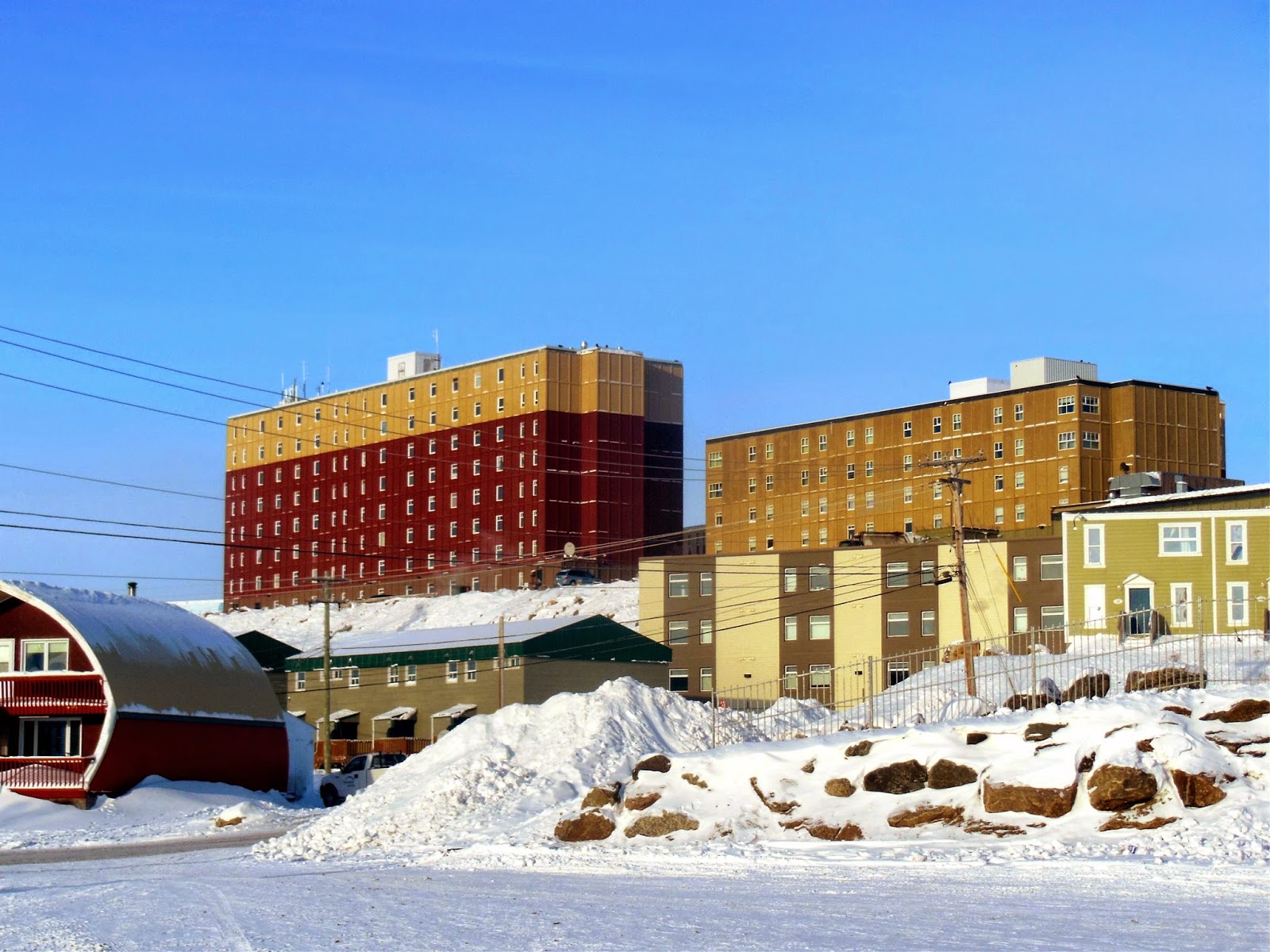The conference planners had made arrangements to have a school bus pick up the teachers from their hotels and drop them off at Inuksuk High School. I chose to walk, preferring the fresh arctic air. Walking was my main mode of transportation when I resided in Iqaluit two years ago, and from it, I learned that all the important locations were within walking distance.
 |
| Brown Building where Frobisher Inn is located. |
The
conference would be conducted in English & Inuktitut. Since many attendees were not bilingual,
translators were hired to convey what was being said. The translators sat in booths at the back of
the gym and spoke into microphone headsets.
Their translations were picked up by small portable receivers that you
could borrow for the duration of the conference.
The
morning announcements consisted of reminding participants to make sure their
timetables were full, choose (an)other class(es) if their original choice(s)
were cancelled, and to not throw out any leftover unwrapped food from the boxed
lunches. The leftovers would be donated
to local homeless shelter and soup kitchen.
Unfortunately, some instructors would be unable to attend the conference
due to travelling issues. Air travel in
the territories can be good or it can be really bad. Mother Nature is the ultimate decider. I have heard stories of people being stranded
in communities for days & even weeks because they can't fly out or their
plane can't land in a community because of adverse weather.
Professor Dale Willows from the Ontario Institute for Studies in Education (OISE) was the first keynote speaker. (OISE is part of the University of Toronto). Her presentation was an overview on the Balanced Literacy Diet (BLD), "a framework that presents literacy concepts using the familiar terminology of a healthy diet." The English language centered framework/program has been around for several years and currently caters (pun intended) to the Pre-K to Grade 6 Grades. From the research & videos professor Willows presented, the BLD appears to be a successful program. If you want to know more about the framework, check out their detailed website.
Everyone
went to their respective workshops after a short 'Nutritious Break' that
offered coffee, tea, fruits, and fresh muffins.
The snacks were prepared by the catering services of the Frobisher
Inn. The workshops would be held at the
high school and Aqsaarnit Middle School.
A school bus was available to transport the teachers between schools.
The
first workshop I attended was Adding
Inuit Language & Culture to Classroom & School, facilitated by
David Serkoak, a former principal of Joamie School. The workshop focused on "how to
incorporate Inuit language & culture in all aspects of teaching." Participants also shared their ideas as well
as life experiences. The workshop was conducted
in Inuktitut & English. Many veteran
Inuit teachers attended the workshop and shared stories of what education was
like before the creation of Nunavut.
 |
| Take only one bagged lunch. You're being watched. |
 |
| Downtown Iqaluit. |
The last workshop of the day was Dyslexia: A Reading Disability not a Learning Disability. The facilitator was Kenton Pennington, a Nunavut teacher who is dyslexic. The workshop took place at the high school. (This time, I took the bus from the middle school). His workshop focused on dispelling common myths about dyslexia and how to handle the students with the disability. I was glad he also taught us some basic methods on how to spot students with dyslexia. Many people feel stigmatized and do their best to hide the disability.
 |
| Craft Sale |
 |
| One of the many performers at the evening coffee house. |
 |
| Usha James |
The first workshop I attended that morning was Follow The Money, facilitated by Dominic Tremblay. He showed us how to transform our classrooms into a mini-economy with a specific project. The example project he used was getting us to build the tallest tower that could support a 1 kg weight. The materials at our disposal were tape, straws, paper cups & plates, pencils and other things. We had to buy these materials with play money or could trade them with other groups. I was surprised by how many topics you could teach with such a project. The topics included: borrowing, online shopping, taxes, buying supplies, the impact of counterfeit currency, and selling services. Unfortunately, the tower my partner & I built wasn't the tallest.
In the afternoon, I attended workshops on effective
presentation skills and Inuit social history.
I signed up for the presentation workshop because I wanted to strengthen
my public speaking skills. The technology and differentiation workshop would teach me how to incorporate more technologies into my lessons and keep them fresh & exciting. Students today are heavy into digital technologies, so it's only fair that teachers find ways to incorporate them in the classroom. Otherwise, you lose your audience.
Many teachers chose to go out for dinner rather than stay
at the high school. One of the good
things about Iqaluit is that it has a selection of bars and restaurants. Many of us teachers congregated at the Storehouse Bar & Grill, a pub/restaurant located in the same building as the Frobisher Inn. Over the course of the evening, I met &
spoke with teachers from all over the Qikiqtani Region, and learned what
teaching was like in their communities.
I also shared my experiences of living and teaching in the north.
To Be Continued . . .
*My 100th Post!









>My 100th Post!
ReplyDeleteCongratulations! You're very consistent. I really enjoy your pictures of the towns and hamlets.